Leaving the Mound
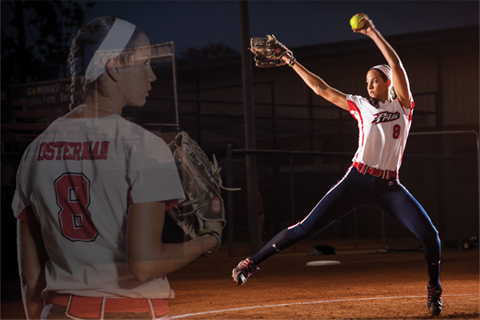
There was a baseball game going on at UFCU Disch–Falk Field on an unseasonably chilly April evening. A storm was coming in from the east, and the sky was darkening faster than usual for spring. The lights at the University of Texas’ Red & Charline McCombs Field, tucked next door, were on, the softball field freshly mown and lined. Unlike across the street, the field and stands were empty—save one lone player standing on the mound, snapping the ball up and into her glove with a quick and athletic flick of the wrist, and a photography crew. Cat Osterman, days after announcing her retirement from pro softball, worked her poses as a cold, light rain began to fall. In the twilight, Osterman commanded the field.
You don’t have to know one whit about softball to know Catherine “Cat” Osterman. The Houston native is a legend in the sport and one of UT’s all-time revered athletes, male or female. Google her name and about 267,000 items pop up in the blink of an eye. One fan reminisced about watching Osterman: “Living in Houston at the time Cat was playing at UT, I was so proud to say I was from the same hometown. Cat played about the same time my oldest son was [at school there]; as a mother of two sons and a former athlete, it was nice to show them a successful, athletic woman playing sports.”
Osterman’s stats are impressive: two-time Olympian, two-time World Champion, three-time National College Player of the Year, four-time All-American. She struck out 554 batters as a UT freshman in 2002, the second-best single season total in NCAA history at the time—a record she herself topped in her junior and senior seasons. She was the first player in NCAA history to surpass 2,000 strikeouts for a career and set records at Texas in career ERA (0.51), wins (136), shutouts (85), and no-hitters (20). Osterman played on the USA National Team, where she won Olympic medals (a gold medal in 2004 and a silver in 2008) and helped the team to three World Cup Championships (2006, 2007, and 2010). Since her time at UT and with the National Team, Osterman has played pro softball as part of a Japanese team (the Toyota Shokki) and with two U.S. National Pro Fastpitch (NPF) organizations, the Rockford Thunder and the USSSA Pride, based in Florida. The list of accolades, awards, and records could go on but at some point, it almost seems overkill.
On her thirtieth birthday this last April 16, the legendary leftie announced her retirement from pro softball at the end of this 2013 summer season with the Pride. She’ll play on Texas’ soil one last time, in Corpus Christi, against the Akron Racers on June 13–15. Those games will mark the end of an era: NPF Commissioner Cheri Kempf was quoted on the NPF website as saying, “Cat has had a profound impact on our sport and has elevated the prominence of our league. Professional softball won’t be the same without her.”
When you’re in the best shape of your life and still having an impressive impact on your sport, how do you know that it’s time to retire? “I always knew I didn’t want to be a ‘lifer’,” explained Osterman. “Playing at this level can be overwhelming, with people demanding a certain level of my time as well as the game being demanding of me physically. It wears on you.” She talked about how tired she was after the 2004 Olympics; the day after her last game, while the other National Team athletes were sightseeing and having a break in Greece, Osterman was on a plane to the States and expected to pitch at UT’s “Welcome Back, Cat” (“It was the first fall game; there was a super cool poster; the fans were great and it was wonderful.”). Bone tired, Osterman told Coach Connie Clark she needed some time off; the two weeks her coach gave her stretched into a month. At one point in the past, she sat down to carefully analyze her career trajectory—you’ll learn quickly that Cat Osterman is thoughtful, deliberate, and nothing if not focused—and had targeted 2012 as a possible retirement date. Injuries in 2010 (thoracic outlet syndrome) and 2011 (strained bicep) actually kept her in the game longer. “I wanted to be completely well in my last season, going out healthy and in good shape,” said the woman who readily admits to being “a perfectionist.”
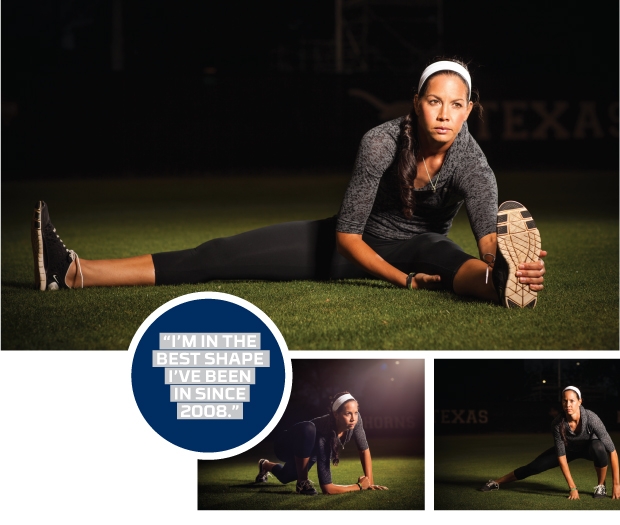
Like many athletes, Osterman had noticed that as she got older, her body was becoming a bit slower to recover. After the grueling pace of working out with the National Team and getting ready for the Olympics, Osterman ruefully joked that she “fell off the workout wagon.” As a pro, there’s no strength and lifting coach with the team, and each athlete puts together her own additional workouts because, as Osterman explained, “at that level, you know what you need.” She’d run 2–3 miles fairly regularly and lift some—but not much—which, for the 6’2” leggy brunette, is falling off the wagon. Osterman was in this period when she noticed the workouts that UT strength trainer Lance Sewell was putting his baseball players through in the gym (former athletes are welcome at the school’s workout facilities). “Lance was hired at the end of my UT career and he just started working with the softball girls last year, so I hadn’t worked with him,” she explained. “Their workouts looked so good and I asked around about him,” she continued. Through a mutual friend, Osterman reached out to Sewell via Twitter, asking if she could train with him. He agreed and they began a rigorous program: “We started out in December with almost intro stuff, focusing a lot on balance and getting in the gym for strength training four times a week. I run on my own—I try to make it four times a week, but it’s often three—and I’m pitching two to three days a week.” Osterman gets “something” in, and that includes a lot of stretching and yoga along with Sewell’s gym sessions, at least five to six days a week (do the math, and clearly many of those days involve more than one workout). The physical focus has certainly paid off and she’s justifiably proud of the results; the 30-year-old recently had her body fat tested at the Fitness Institute of Texas (FIT) and found it to be lower than in her junior and senior years in college. “I’m in the best shape I’ve been in since 2008,” Osterman averred. “I’m probably in the best shape of my life.”
Osterman certainly looks it. She’s lean and moves with a fluid grace that makes you forget she’s tall. She came into her famous height surprisingly late—between junior high and college, Osterman went from 5’6” to 6’2”, a trajectory that mirrored her dad’s growth, who entered college at 5’11” and graduated at 6’5” (that height is a benefit in basketball, which is the family’s sport of choice; her dad, a former player, is a coach, as are an uncle who just retired in San Antonio and an aunt). Growing up, Osterman also played basketball (as well as several other sports), until she decided to focus on softball. Though she fell in love with pitching at age 11 when she had her first lesson, it wasn’t until later that she chose to focus on it, and Osterman credits that mixed athletic background with keeping her healthy throughout her career. She’s a commanding presence, even in workout clothes, with her poise and million-mile legs but laughs when asked if she ever considered modeling. “I’m not super girlie,” Osterman said (though her stylish sunglasses and the eye liner and mascara in her workout bag might suggest differently). “My friends have told me, ‘You should strut it more than you do.’” She shrugged and followed with, “I have an athletic body, not a modeling body. I like how I look most of the time.” That healthy attitude led Osterman to participate in ESPN’s famous 2009 “Body Issue,” which had a large section—many forget that the regular magazine sports news coverage appeared within as well—devoted to images of a variety of athletes’ bodies. The idea (in addition to boosting subscription rates and challenging Sport’s Illustrated’s “Swimsuit Issue”) was to celebrate those who are athletically fit, whose bodies often look different from those of the models seen in ads and fitness magazines. Osterman appeared in a group, nude save for a strategically placed softball glove and cleats (“We thought it was weird; why am I the only one in shoes? Is it because I’m a pitcher?”) in the “Bodies We Want” pictorial. Prior to participating, Osterman talked to her parents about the shoot: “I explained what ESPN was going for and neither were in disagreement with my decision but it took [my parents] a little time to come around.” She also thought about her fans—“that kind of thing can go either way”—and even had a moment of doubt during the actual shoot. “It was a surprisingly emotional experience,” Osterman remembered. “I had a robe on every second I could, and I found myself second guessing…was this the right thing to do?”
There’s been no second-guessing when it comes to coaching, however. Osterman has always felt that teaching her sport was in her future. She spoke of the example set by her family, many of whom, as mentioned earlier, are coaches (one of her two younger brothers is currently working toward becoming a swim coach) and teachers (her mother and grandfather). “I always knew growing up that I wanted to coach,” Osterman said. “I would love to be remembered as a great coach at the end of my career.” She spoke with pride about the team at St. Edwards University, where she has been an assistant coach under her longtime friend Lindsay Gardner, another standout UT softball player, USA National Team member, and former pro with the Rockford Thunder. Gardner retired as a player in 2007 and, after several years in a variety of positions—the co-founder and head coach of Platinum Softball in Austin, as well as a private hitting and fielding instructor and an assistant coach at St. Ed’s—became the Hilltopper’s head coach in 2011. The Division II team has shown dramatic improvement under Gardner’s tutelage, and this success promises to continue with the dynamic duo of friends. “Lindsay’s always been like a big sister to me,” Osterman said fondly. “Because we were friends, I didn’t want to push the coaching thing—not everybody wants to work with a friend—and so I was pleased
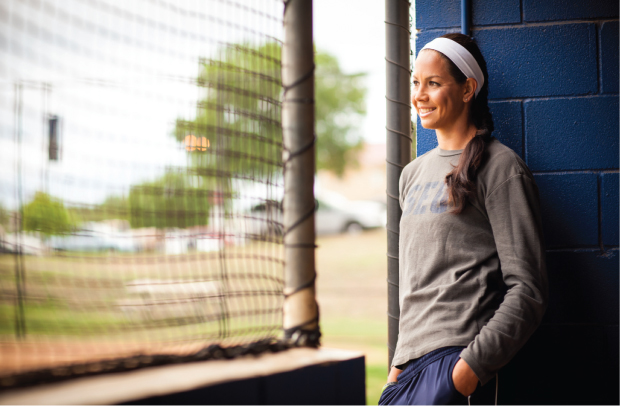 when a mutual friend told me that Lindsay was open to having me as an assistant.” She explained that the two make a great pair, with “polar opposite personalities” whose strengths “balance out” the coaching experience. “It’s been really easy to get into this role,” Osterman continued. She’s glad that she’s still able to demonstrate what she’s instructing—“I want to be able to give my players all the tools and then watch them be successful”—and sophomore pitcher Sarah Debrow must be reaping some benefits, since she was recently named Heartland Conference Pitcher of the Week for the third consecutive week and the fourth time this season. Osterman feels she’s learning from this partnership with Gardner, just as she’s learned from all the coaches she’s worked with in the past. “All of the coaches I’ve had have played a part in my development,” Osterman responded when asked which of her former coaches has been most influential. “Coach Clark—though, at the time, I was stubborn and questioning. But I believe I wouldn’t have been a good athlete if I weren’t. Coach Clark knew how to push me, to not let me settle for less than the best I could be.” She learned as an assistant coach at DePaul University under National Fastpitch Coaches Association (NFCA) Hall of Famer Eugene Lenti, the all-time winningest coach at the university, who hit his 1,000th win mark in ’09; Osterman worked as an assistant coach for three years in Lenti’s program, which is known for exceptional pitching. “I learned a lot, but I didn’t like those Chicago winters,” said the Texas native.
when a mutual friend told me that Lindsay was open to having me as an assistant.” She explained that the two make a great pair, with “polar opposite personalities” whose strengths “balance out” the coaching experience. “It’s been really easy to get into this role,” Osterman continued. She’s glad that she’s still able to demonstrate what she’s instructing—“I want to be able to give my players all the tools and then watch them be successful”—and sophomore pitcher Sarah Debrow must be reaping some benefits, since she was recently named Heartland Conference Pitcher of the Week for the third consecutive week and the fourth time this season. Osterman feels she’s learning from this partnership with Gardner, just as she’s learned from all the coaches she’s worked with in the past. “All of the coaches I’ve had have played a part in my development,” Osterman responded when asked which of her former coaches has been most influential. “Coach Clark—though, at the time, I was stubborn and questioning. But I believe I wouldn’t have been a good athlete if I weren’t. Coach Clark knew how to push me, to not let me settle for less than the best I could be.” She learned as an assistant coach at DePaul University under National Fastpitch Coaches Association (NFCA) Hall of Famer Eugene Lenti, the all-time winningest coach at the university, who hit his 1,000th win mark in ’09; Osterman worked as an assistant coach for three years in Lenti’s program, which is known for exceptional pitching. “I learned a lot, but I didn’t like those Chicago winters,” said the Texas native.
More than anyone, Osterman has learned from her dad. “My dad has always been my rock,” she said. “I could always look up to find him in the crowd [at Texas] and he’s given me a fist pump before and after every game.” Gary and Laura Osterman have been solid supporters from the early years, when there was a home plate painted on the family’s driveway and floodlights on the side of the house so their daughter could practice at night (“the neighbors used to laugh and call it ‘the airstrip’”). She said her parents “pushed but never forced” her to practice and, once she hit college, they “cut me loose,” meaning that there was no micro-coaching, no yelling instructions from the stands, no debating her choices—just support and respect. Osterman credits her drive and focus to this parenting style: “Practicing was 100 percent when I wanted to go out. I didn’t have to practice all the time—unless I wanted to—but I had to have purpose if I was practicing with my dad. When I did, I knew I was there to learn lessons and to spend my dad’s time wisely.” As a result, she developed that love of trying to make the ball do what she wanted that led her to perfect her pitches.
When asked about what will follow once she takes the mound for the last time in August this year, Osterman said, “I don’t know yet what I’m going to do to fuel those competitive juices.” She’s realized how much she likes to work out, so she sees different athletic adventures in her future—perhaps a triathlon or half marathon. Though she has enjoyed providing commentary for ESPN and the Longhorn Network, it’s not the same as playing, and “I battle with how much I want the game to rule my life.” She’s certain that she’ll stay here in Austin, and she’s in the process of applying to the graduate program at St. Ed’s to work on her Master’s degree. Osterman will continue to have fun: For the last four years, she’s gone on a snowboarding trip with friends, and she’s trying to talk her family into taking a vacation together. She’ll keep taking her beloved dogs on outings, such as to Bastrop State Park where they cover the trail hiking together. As she continues to coach at St. Ed’s, she hopes that there will be more time to give clinics and make appearances; she’s talking about doing another pitching DVD, and she’s excited about giving back to the community and furthering her sport through involvement with the nonprofit RBI Austin.
Whatever Cat Osterman decides to do in the future, she’s made her mark on softball—all by the age of 30—and so, perhaps, it’s time for a new moniker—“Catherine the Great.” Osterman would probably laugh at the suggestion, though her fans might beg to differ.
Cat's Favorite Pitch: The Curveball
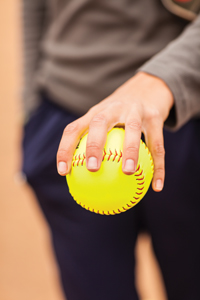
The Grip
Osterman’s large hands help her grip the softball with her fingers. It’s been said her pitches “dance”; the curveball is her go-to throw. Though she commands six different pitches, Osterman chooses accuracy over muscle and rarely throws a fastball.
In regards to the pitching image[s], there's no way to explain it being a curveball but here's my outline on how to throw a pitch:
Image 1-3:
Pre-motion: It's important to have a loose and smooth pre-motion. I bring mine over my head in order to create a long loose arm and leverage. As my arms drop down, I keep them in a straight-arm circle, which comes down in front of my body, behind my hip, and eventually back up over my head.
Image 4:
Power position: As my arm starts the motion, my body is turning to open up. I open to be perfectly perpendicular to the plate. At this point, I am powerfully striding towards the plate while keeping my body tall and aligned to my target.
Image 5: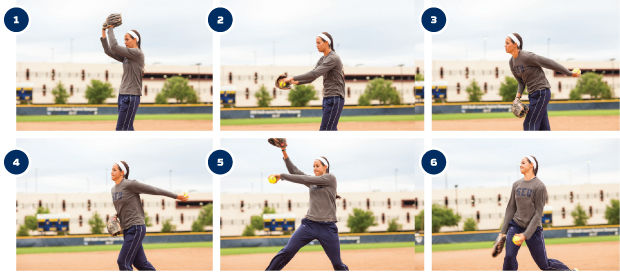
From the power position, I accelerate my arm down to release point, where I drive my legs and snap my wrist as hard as I can. Pictured is my follow through, which is a natural relaxed finish after releasing the ball.
In order to see Osterman give a video demonstration of how to throw a curveball—in addition to two of Osterman’s other favorite pitches, the riseball and the dropball—watch this USA/ASA Softball video featuring Osterman as she breaks down each of the steps verbally (http://www.youtube.com/watch?v=iG4fIor1hy4). Then, she demonstrates.
Makeup by Lauren Lumsden & hair by Lacey Fuentes of Rae Cosmetics






